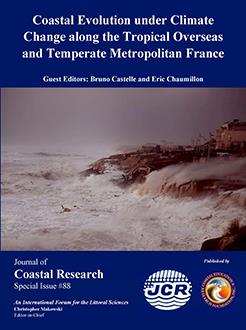Héquette, A.; Ruz, M.H.; Zemmour, A.; Marin, D.; Cartier, A., and Sipka, V., 2019. Alongshore Variability in Coastal Dune Erosion and Post-Storm Recovery, Northern Coast of France. In: Castelle, B. and Chaumillon, E. (eds.), Coastal Evolution under Climate Change along the Tropical Overseas and Temperate Metropolitan France. Journal of Coastal Research, Special Issue No. 88, pp. 25–45. Coconut Creek (Florida), ISSN 0749-0208.
As along many parts of the world's shoreline, the coastal dunes extending along the macrotidal coast of northern France represent important defenses against marine flooding. The impacts of storms on the upper beach and foredunes and their post-storm recovery were analyzed using nearly 10 years of offshore wave measurements, water level records, wind measurements, and in situ and airborne LiDAR topographic surveys of the beach and foredunes. Our results show that coastal dunes located at a relatively short distance apart along a coastal stretch with the same wave exposure can have significantly different responses to storms. Not only the impacts of storm events were greater on some dunes, but post-storm recovery also varied from one foredune to another. A strong alongshore variability in dune erosion and recovery was observed with a positive eastward gradient in dune volume change, probably related to longshore and onshore-directed sediment supply. Our measurements revealed that even where the foredune underwent significant erosion during the first years of the survey period, progressive full dune recovery took place through the development of a sand ramp at the dune toe that favored landward sediment transport from the upper beach to the foredune. This period was followed by an unusual series of closely spaced storms during fall-winter 2013-2014 that had major impacts on the coasts of Western Europe. Several of these storms were responsible for extreme water levels, which resulted in significant retreat of the dune front and massive volume loss in places. Our analyses show that the maximum water levels reached during storms represent a major factor explaining dune erosion compared to wave energy that is of secondary importance along this macrotidal coast. Our results also suggest that dune volume change during storms and subsequent recovery were largely controlled by the initial dune and upper beach morphology. A strong correspondence was found between dune front volume change and initial upper beach width and with dune toe elevation, but a somewhat weaker relationship was observed between dune volume change and initial dune height.





